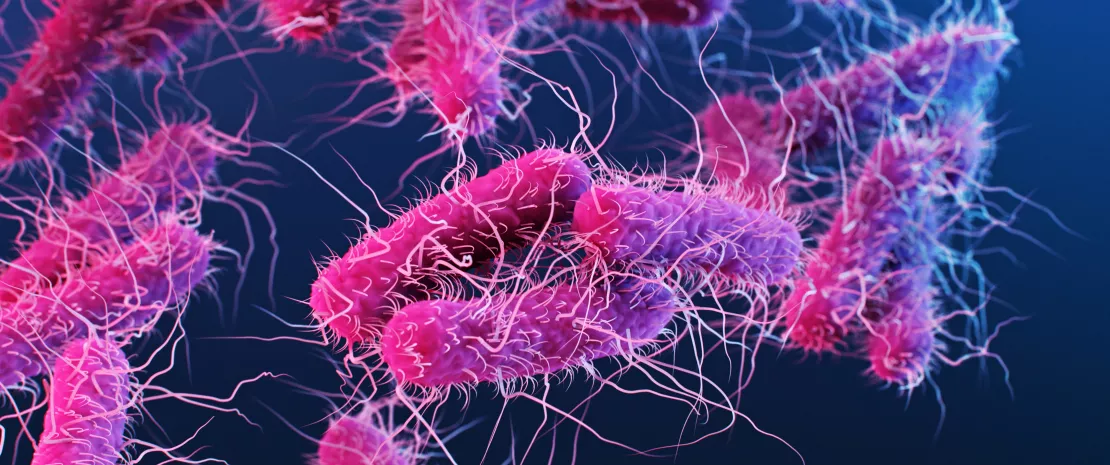Unexpected effect of famous antibiotic on fungal microbiota
Until recently, antibiotics had been thought to promote fungal growth. However, a study published in Microbiome suggests that amoxicillin/clavulanic acid reduces the gut mycobiota’s fungal load. This unexpected effect is undoubtedly linked to an increase in Enterobacteriaceae species and reveals the delicate balance between bacteria and fungi in the gut microbiota.
Sources
This article is based on scientific information

About this article
In studies of the gut microbiota, fungi have long been overlooked, with the focus instead falling on bacteria, the main microorganisms found in the gut. We still have a limited understanding of how fungi interact with bacterial communities in the gut microbiota and of how antibiotics impact the gut mycobiota. French researchers have tried to shed some light on the matter by studying the effect of amoxicillin/clavulanic acid (AMC) on bacteria and fungi in the gut microbiota of mice and infants.
Unexpected, antibiotic-dependent fall in gut fungal load
Their study on conventional mice showed, as expected, that AMC administered for ten days reduced the amount of bacteria present in the feces and gut. Far more surprising, the treatment also greatly reduced the overall fungal population compared to controls. A “cocktail” of broad-spectrum antibiotics (ampicillin, metronidazole, neomycin, and vancomycin [VA]...), had the same impact. However, mice that received a fecal microbiota transplant (FMT) from healthy adult humans showed a response in their mycobiota that was antibiotic-dependent: the fungal load was again lower with amoxicillin/clavulanic acid but increased with VA. In parallel, the researchers analyzed 19 gut microbiota samples from 7 infants aged 2 to 4 months treated for otitis media with amoxicillin. This antibiotic, which is very similar to AMC, also reduced the bacterial and fungal load during treatment.
The ambivalent role of antibiotics
Bacterial and fungal balance transformed by amoxicillin/clavulanic acid
The researchers found that the alpha and beta diversity of the fungal population in the feces of conventional mice treated with AMC had decreased, but that the share of Aspergillus, Cladosporium, and Valsa had increased compared to untreated mice. Bacterial alpha-diversity had also decreased, but differential analysis revealed a shift in bacterial families in the gut microbiota after treatment, with an increase in Enterobacteriaceae.
Suspecting a link between the increase in this bacterial family and the reduction in fungal load, the researchers isolated 13 bacteria from the feces of mice treated with AMC and coincubated them with S. cerevisiae. Nine of them inhibited the growth of this yeast, all of which were Enterobacteriaceae. These Enterobacteriaceae, and in particular E. hormaechei, also reduced the growth of Candida albicans. In addition, when colistin, an antibiotic that targets Enterobacteriaceae, was administered to the mice that had received a human FMT, the mice’s gut fungal abundance increased. After further in vitro and in vivo tests to observe the interactions between gut bacteria and fungi, the researchers concluded that Enterobacteriaceae were at least partly involved in the dysbiosis of the gut mycobiota caused by AMC. Several mechanisms could be at play, including competition for certain nutrients between these bacteria and fungi.
A change of paradigm?
Although carried out on mice and a small cohort of infants, this study challenges the preconceived idea that all antibiotics promote the proliferation of fungi in the gut microbiota. Amoxicillin/clavulanic acid, a widely prescribed antibiotic, decreases the overall abundance of the gut fungal population and remodels gut microbiota composition in terms of fungal and bacterial species. The study also reveals the close links between bacteria and fungi in the gut microbiota via the complex alterations in the balance of their populations that antibiotics can provoke. Confirmation of these results on larger cohorts may lead to changes in medical practice, particularly in situations where the mycobiota plays a significant role in patient health.
What is the World AMR Awareness Week?
Each year, since 2015, the WHO organizes the World AMR Awareness Week (WAAW), which aims to increase awareness of global antimicrobial resistance.
Held on 18-24 November, this campaign encourages the general public, healthcare professionals and decision-makers to use antimicrobials carefully, to prevent the further emergence of antimicrobial resistance.

"Excellent" -Asana Assane (From Biocodex Microbiota Institute on X)











